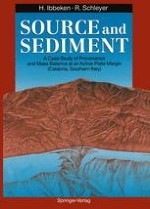1991 | OriginalPaper | Chapter
Development of Grain-Size Distributions
Authors : Professor Dr. Hillert Ibbeken, Dr. Ruprecht Schleyer
Published in: Source and Sediment
Publisher: Springer Berlin Heidelberg
Included in: Professional Book Archive
Activate our intelligent search to find suitable subject content or patents.
Select sections of text to find matching patents with Artificial Intelligence. powered by
Select sections of text to find additional relevant content using AI-assisted search. powered by
Calabrian river-mouth sediments are both bimodal or unimodal. The gravel mode of the bimodal distributions, mostly Rosin-distributed, is interpreted as a first-order element, a primary feature inherited from the jointed and weathered source rocks, whereas the sand mode can be seen as a secondorder element acquired during fluvial attrition. The shape of the gravel mode varies significantly from the jointed and weathered source rocks over the river mouths to the shoreface, the latter exhibiting lognormal grain-size distributions.If the percentage of the fraction 1–20 mm exceeds about 35%, the distributions became unimodal. Thus this fraction is crucial for modality and is called, consequently, a third-order element.All single factors assumed to control modality alone, such as relief, basin shape, source rock petrography, the petrographical composition of the river sediment itself or postdepositional refill of interstices, fail to exert a significant or mono-causal influence on modality. In addition, no hydrodynamic conditions are known which specifically select, as a rule and within the grain-size range of gravel and sand, this fraction of 1–20 mm. Thus, other possibilities being excluded, only availability remains, but not in the sense of source area-related sediment production. It is assumed that different floods drive the “sedimentary mill” of these mountain rivers differently and that the formation of the fraction 1– 20 mm is sensitive to these differences.
